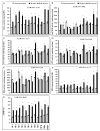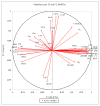Water Deficit Stress Tolerance Potential of Newly Developed Wheat Genotypes for Better Yield Based on Agronomic Traits and Stress Tolerance Indices: Physio-Biochemical Responses, Lipid Peroxidation and Antioxidative Defense Mechanism
- PMID: 35161446
- PMCID: PMC8839292
- DOI: 10.3390/plants11030466
Water Deficit Stress Tolerance Potential of Newly Developed Wheat Genotypes for Better Yield Based on Agronomic Traits and Stress Tolerance Indices: Physio-Biochemical Responses, Lipid Peroxidation and Antioxidative Defense Mechanism
Abstract
Changing environmental conditions, fresh water shortages for irrigation and the rapid increase in world population have created the problems of food insecurity and malnutrition. Different strategies, including the development of water stress-tolerant, high-yielding genotypes through breeding are used to fulfil the world food demand. The present study was conducted for the selection of high-yielding, drought-tolerant wheat genotypes, considering different morpho-physio-biochemical, agronomic and yield attributes in relation to the stress tolerance indices (STI). The experiment was carried out in field in a split-plot arrangement. Water deficit stress was maintained based on the number of irrigations. All genotypes showed a differential decreasing trend in different agronomic traits. However, the increasing or decreasing trend in leaf photosynthetic pigments, non-enzymatic and enzymatic antioxidants under limited water supply also found to be genotype-specific. Genotypes MP1, MP3, MP5, MP8 and MP10 performed better regarding the yield performance under water deficit stress, which was associated with their better maintenance of water relations, photosynthetic pigments and antioxidative defense mechanisms. In conclusion, the physio-biochemical mechanisms should also be considered as the part of breeding programs for the selection of stress-tolerant genotypes, along with agronomic traits, in wheat.
Keywords: agronomic traits; breeding; oxidative stress; photosynthetic pigments; water relations; water stress; yield.
Conflict of interest statement
Authors have no conflict of interest.
Figures




Similar articles
-
Alpha-tocopherol fertigation confers growth physio-biochemical and qualitative yield enhancement in field grown water deficit wheat (Triticum aestivum L.).Sci Rep. 2019 Sep 9;9(1):12924. doi: 10.1038/s41598-019-49481-7. Sci Rep. 2019. PMID: 31501498 Free PMC article.
-
Molecular Genetic Diversity of Local and Exotic Durum Wheat Genotypes and Their Combining Ability for Agronomic Traits under Water Deficit and Well-Watered Conditions.Life (Basel). 2023 Dec 1;13(12):2293. doi: 10.3390/life13122293. Life (Basel). 2023. PMID: 38137895 Free PMC article.
-
Genetic Potential and Inheritance Patterns of Physiological, Agronomic and Quality Traits in Bread Wheat under Normal and Water Deficit Conditions.Plants (Basel). 2022 Mar 31;11(7):952. doi: 10.3390/plants11070952. Plants (Basel). 2022. PMID: 35406932 Free PMC article.
-
Assessment of genetic variation among wheat genotypes for drought tolerance utilizing microsatellite markers and morpho-physiological characteristics.Heliyon. 2023 Nov 3;9(11):e21629. doi: 10.1016/j.heliyon.2023.e21629. eCollection 2023 Nov. Heliyon. 2023. PMID: 38027610 Free PMC article.
-
A Physio-Morphological Trait-Based Approach for Breeding Drought Tolerant Wheat.Front Plant Sci. 2020 Jun 3;11:715. doi: 10.3389/fpls.2020.00715. eCollection 2020. Front Plant Sci. 2020. PMID: 32582249 Free PMC article. Review.
Cited by
-
Alpha lipoic acid mitigates adverse impacts of drought stress on growth and yield of mungbean: photosynthetic pigments, and antioxidative defense mechanism.PeerJ. 2024 Apr 29;12:e17191. doi: 10.7717/peerj.17191. eCollection 2024. PeerJ. 2024. PMID: 38699184 Free PMC article.
-
Drought Resilience in Oil Palm Cultivars: A Multidimensional Analysis of Diagnostic Variables.Plants (Basel). 2024 Jun 8;13(12):1598. doi: 10.3390/plants13121598. Plants (Basel). 2024. PMID: 38931030 Free PMC article.
-
Conferring of Drought and Heat Stress Tolerance in Wheat (Triticum aestivum L.) Genotypes and Their Response to Selenium Nanoparticles Application.Nanomaterials (Basel). 2023 Mar 9;13(6):998. doi: 10.3390/nano13060998. Nanomaterials (Basel). 2023. PMID: 36985894 Free PMC article.
-
Role of gibberellins, neem leaf extract, and serine in improving wheat growth and grain yield under drought-triggered oxidative stress.Physiol Mol Biol Plants. 2023 Nov;29(11):1675-1691. doi: 10.1007/s12298-023-01402-9. Epub 2023 Dec 21. Physiol Mol Biol Plants. 2023. PMID: 38162918 Free PMC article.
-
Biochar-Coconut Shell Mixtures as Substrates for Phalaenopsis 'Big Chili'.Plants (Basel). 2025 Jul 8;14(14):2092. doi: 10.3390/plants14142092. Plants (Basel). 2025. PMID: 40733329 Free PMC article.
References
-
- Mancosu N., Snyder R.L., Kyriakakis G., Spano D. Water scarcity and future challenges for food production. Water. 2015;7:975–992. doi: 10.3390/w7030975. - DOI
-
- FAO Declaration of the World Summit on Food Security; Proceedings of the World Summit on Food Security; Rome, Italy. 16–18 November 2009.
-
- Shideed K.H. Informing Policy Development for Sustainable and Productive Food Production Systems in Dry Areas. International Center for Agricultural Research in the Dry Areas (ICARDA); Aleppo, Syria: 2011.
-
- Fraiture C.D., Molden D., Wichetns D. Investing in water for food, ecosystem and livelihoods: An overview of the comprehensive assessment of water management in agriculture. Agric. Water Manag. 2010;97:495–501. doi: 10.1016/j.agwat.2009.08.015. - DOI
-
- Suleimenov M., Saparov A., Akshalov K., Kaskarbayev Z. VI-6 Land degradation issues in Kazakhstan and measures to address them: Research and adoption. Jap. Soc. Soil Sci. Plant Nutr. Abstr. 2011;57:225.
LinkOut - more resources
Full Text Sources

